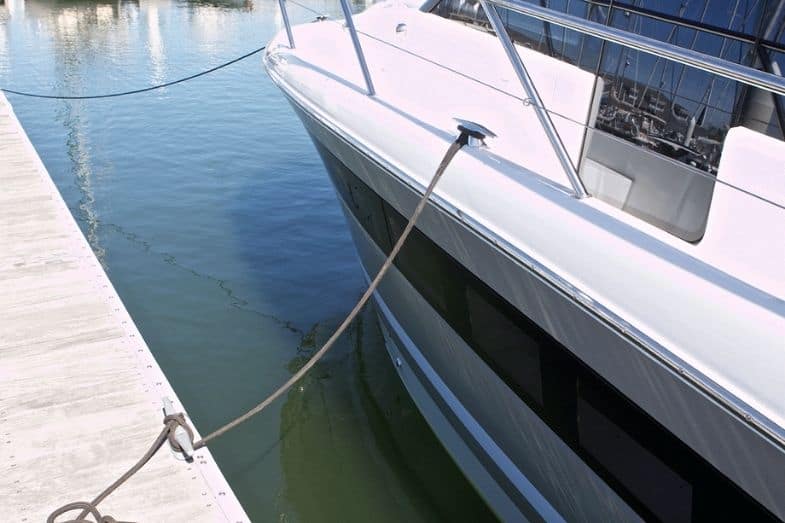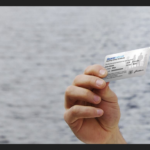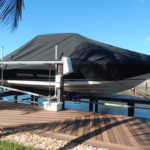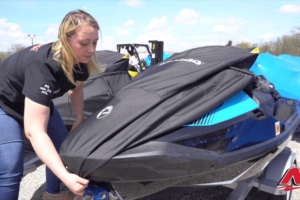How to drive a boat? Driving a boat is not difficult once you know the basic fundamentals. In this article, I will describe how to drive a motorboat safely and with ease.
How to drive a boat for beginners? The 10 fundamentals of driving a motorboat are as follows:
- Run the Blower
- Start the Engine
- Attach the Lanyard to the Life Jacket
- Check the Completeness of Everyone’s Gear
- Remove Boat Lines
- Engage Forward
- Control the Wheel
- Advance the Throttle
- Adjust Your Speed
- Control Your Speed
To drive a boat, you must satisfy the following:
- You must be legally allowed to drive one.
- You should obtain a safety certification or complete a course on boating education.
- You should apply the step-by-step process for driving one, from running the blower to controlling the speed to docking it.
Read on to learn more about how to drive a motorboat and how to drive a pontoon boat, including the 10 fundamentals.
How to Drive a Boat?
To drive a boat, you have to know basic boat-driving skills. Let’s start with the fundamental process of driving a motorboat.
Basically, it will be easier for you to learn how to drive a boat if you learn this process. It will be easy for you to familiarize yourself with driving a bass or pontoon boat or just about any other boat type, even if their features somehow differ from one another.
The 10 fundamentals of driving a motorboat, speed boat, or pontoon boat are below.
1. Run the Blower
When operating a motorboat, you don’t right away sit on the driver’s seat and start the engine. This is particularly true if your motorboat has an engine compartment and is powered by gasoline. In which case, you have to run the exhaust fan according to the manufacturer’s instructions.
This is not only the first step but also an important one. It allows you to ensure that fumes in the compartment will not build up.
As a boat owner and driver, you need to have a pre-departure checklist in which running the blower forms part and parcel of it. Later on, we will expound on the topic of the Pre-Departure Checklist.
2. Start the Engine
Like how you start an automobile, insert the key into the ignition, and turn to start the engine—some of the newest motorboats released in the market feature a push-button ignition. In which case, you have to press the appropriate button to start the engine.
3. Attach the Lanyard to the Life Jacket
Some motorboats feature an engine safety cut-off. It turns the engine off automatically in case you leave the helm for whatever reason. This feature is also known as a “kill switch.”
If your boat has this feature, make sure to attach the lanyard to the life jacket. Clip the lanyard on the jacket’s belt loop.
4. Check the Completeness of Everyone’s Gear
Regularly check the completeness of your gear before leaving the pier. If you have companions with you, it is important that you also check their gear’s completeness.
Before disembarking, confirm the preparedness of everyone.
5. Remove Boat Lines
Boat lines are ropes that secure your motorboat to the slip, pier, or dock. These are the mooring lines, dock lines, and spring lines, among others. Of course, you have to detach them all to move your boat and start driving.

6. Engage Forward
Once you have detached the boat lines, you may start engaging the boat forward. You may do so by pushing the throttle handle forward. Do this gently until the gear shifts.
In the event that you instead need to reverse the boat to back out of a slip, simply pull back the throttle.
7. Control the Wheel
An important fundamental in our list of how to drive a boat for beginners is to know how to control the wheel. Once you start moving the boat, start spinning the wheel, too, if necessary. Do it as if you are turning the steering wheel of your car to reach the desired direction.
8. Advance the Throttle
To increase your speed, advance the throttle. But, of course, make sure to do this with caution.
9. Adjust Your Speed
Adjust the speed of your boat according to weather conditions. Please do this with caution.
10. Control Your Speed
Like how you drive a car, a truck, or any motor vehicle for that matter, you must be mindful of controlling your speed to prevent any accidents.
If you wish to slow down, pull the throttle back gently towards the neutral position. If you wish to speed up, gently advance the throttle.
Other Tips for Driving a Boat
I have been mentioning earlier how driving a boat is somewhat similar to driving any other motor vehicle. But, of course, that’s not always the case. You need to know about driving a motorboat that isn’t present when driving a car or other types of motor vehicles. Let’s discuss some of them.
1. The Kill Switch
The Kill Switch is also known as the Engine Safety Cut-Off feature of the motorboat.
If you see a tiny red knob located beside the boat’s ignition, then that is your boat’s Kill Switch. If this is in a closed position, trust that it will prevent your boat’s engine from starting. You may open it by sliding or pulling back a small clip attached to it.
The said clip is fastened to a lanyard. This lanyard then features a tether clip on the other end, which you have to fasten onto your life jacket’s loop before you start driving. Don’t forget to do this all the time, as this is necessary for emergency purposes.
You will never know when you need to move away from the helm since you might not be able to come back immediately if you moved away. If this happens, the lanyard will successfully yank the clip out from the knob, causing the engine to stop.
2. The Throttle
If left in the neutral position, the throttle will prevent the engine of your boat from starting. This means that even if your boat’s battery is fully charged and you turn the ignition, your boat’s engine may not start. This may be due to an engaged kill switch, or the throttle is probably still in the neutral position.
So far, we’ve answered how to drive a boat, how to drive a pontoon boat, and how to drive a bass boat. The next thing you should learn is how to operate the boat’s throttle.
How to Operate the Boat’s Throttle
Your boat’s throttle may be compared to your car’s accelerator pedal. When you push it forward, your boat moves forward as well. And the more you push it in the forward direction, the more it speeds up.
However, if you need to slow the boat down, you have to pull the throttle back. You must bear this in mind as you might have to control the throttle every so often. This is particularly true during rainy or windy weather conditions.

This particular topic brings us to another very significant and related topic of situational awareness. It is recommended that when you are driving your boat, be mindful of your surroundings. Be alert in recognizing possible incidences of collision, hitting waves, or the like. That way, you can prevent boat accidents.
It is also recommended that even before you decide to take your boat out, make sure to check the weather condition in your area. This is especially important if you don’t know yet how to drive a boat in rough water or how to drive a boat in waves.
3. How to Steer a Boat?
An automobile and a boat both feature a steering wheel. In general, their steering wheels have the same purpose — to turn the boat or the car in your desired direction. However, operating the steering wheel might be a little more complicated than operating the car’s steering wheel in boats.
Several factors affect the direction of your boat. These include the current, waves, and wind, among others. For instance, if the weather is extremely windy, your boat might not turn exactly in the direction you want it to be.
In fact, this is particularly challenging when docking your boat. New boat drivers say that this is the most challenging part of learning how to drive a boat. But all it takes is practice. With utmost concentration, you will most likely master this skill in no time. Before you know it, you are already taking long cruises.
4. How to Slow Down a Boat?
Do you know that boats don’t have brakes? Boats don’t have seatbelts as well. That’s why you have to master how to make a boat slow down lest you scare your passengers — or even yourself.
Get to know your boat-this should be your first step. Make yourself familiar with all your boat’s features. Observe and learn how much stopping distance you need to achieve a full stop safely.
When familiarizing yourself with stopping distance, keep in mind that this varies. It all depends on how fast your boat is moving before slowing down to a full stop. Again, boats don’t have seatbelts. If you make an abrupt change in speed, you can throw your passengers — and you — off balance. Worse, they might even fall overboard.
Suffice it to say that when adjusting speed or making a turn, do it with utmost caution. If quick maneuvers are unavoidable, always give a warning to your passengers.
In case your boat is moving fast, you may slow it down using the following steps:
- Pull the throttle back to the neutral position;
- Pause for several seconds; and then,
- Shift the throttle into reverse and apply some power.
Pausing for a few seconds in a neutral position is advisable before eventually shifting into reverse. This is so to prevent your boat from experiencing mechanical damage. Furthermore, to prevent the occurrence of boat accidents.
5. Driving Various Types of Motor Boats
Learning the fundamentals of driving a motorboat means that you will more or less be able to operate any other type of motorboat. However, some motorboats somehow need special attention. For instance, if you want to learn how to drive a pontoon boat or how to drive a bass boat, there are additional pointers that you need to familiarize yourself with.
Conclusion – How to Drive a Boat?
How to drive a boat for beginners? How to drive a pontoon boat? The fundamentals of driving a motorboat or pontoon boat are as follows:
- Run the blower
- Start the engine
- Attach the lanyard to the life jacket
- Check the completeness of everyone’s gear
- Remove boat lines
- Engage forward
- Control the wheel
- Advance the throttle
- Adjust your speed
- Control your speed
First and foremost, to drive a boat, you must be legally allowed to drive a boat. You must obtain a safety certification or complete a course on boating education. Once obtained, you should apply the step-by-step process for driving one, from running the blower to controlling the speed to docking it.
Driving a boat indeed has similarities to driving a car, a truck, or other motor vehicles. But there are specific skills you need to master when driving a boat that may not be required when driving other motor vehicles.
This is why before you can legally operate your boat, you must take a course on boat education. Furthermore, you have to obtain a certification related to boat safety. This way, you would know everything there is to know about how to drive a boat. And most of all, it will allow you to achieve an ultimate boating experience.
Related reading:
Best Remote Control Boat for Beginners [Our Top 6 Picks]
How Hard Is It to Learn to Sail a Boat?









